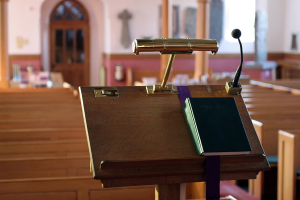40 Years Later: Is the American Flag Still on the Moon?
Debate surfaces as final mission leaves earth
When the astronauts from Apollo 11 first landed on the Moon in 1969, they left a few things behind to commemorate their visit. Today, as Atlantis is on its final mission of the space shuttle program, some analysts are questioning if the American flag remains standing on the moon as it was more than 40 years ago.
Six hours after landing at 4:17 p.m. EST and with less than 30 seconds of fuel remaining, Armstrong took the “Small Step” into our greater future when he stepped off the Lunar Module, named “Eagle,” onto the surface of the moon, from which "he could look up and see Earth in the heavens as no one had done before him."
Neil Armstrong was the first astronaut to step foot on the moon. Buzz Aldrin soon joined him. The two astronauts spent 21 hours on the moon. They did experiments and took pictures. They also brought back 46 pounds of moon rocks.
American flags are iconic and represent special moments in history, including the Marines who raised the flag at Iwo Jima; the one firefighters put up at ground zero; and the one that flew over Fort McHenry and was the inspiration for what would become our national anthem.
“The legacy of flying American flags to space started in 1961 with the flight of the first American astronaut, Alan Shepard. Students from Cocoa Beach Elementary School in Florida purchased a flag from a local department store. The flag was rolled up and placed between cables behind Shepard's head inside his Freedom 7 Mercury spacecraft,” according to National Aeronautics and Space Administration (NASA) archives.
However, a U.N. treaty would not allow the U.S. or any other country to claim the moon as its territory.
Smithsonian curator Allan Needell said in an interview that the flags planted by the crews of all the Apollo missions that landed on the moon were goodwill gestures to the world.
"By and large, the symbol was very much understood for what it was, as a symbol of pride, but also a symbol of humanitarian accomplishment," Needell said.
The astronauts walked around the moon for three hours and most Americans can remember when the men put a U.S. flag on the moon. They also left a sign on the moon.
The sign the astronauts left on the moon says, "Here men from the planet Earth first set foot upon the moon July 1969, A.D. We came in peace for all mankind."
The Apollo 11 astronauts had difficulty getting the pole deep enough into the lunar soil. They also had trouble extending the full apparatus, designed to keep the flag upright and outstretched in a place where there is never any wind, according to NASA archives.
Analysts said they found it odd that the flag did not cast a shadow on the moon, or at least they could not visually see one in the NASA photos.
There is a lively debate going on about whether or not the American flag is still on the moon.
Some scientists say it is uncertain if the flag remained standing or was blown over by the engine blast when the ascent module took off.
Others say the flag fell over during RCS hot fire tests prior to liftoff, while skeptics question that if the flag is not on the moon, where is it?
Most photographers say it’s difficult to capture a photo of something very bright and something else very dim on the same piece of film – so verifying whether the flag is still there through photographs seems impossible.
But, to those who may doubt as to whether or not the American flag is still on the moon, scientists from the John F. Kennedy Space Center NASA answered the question recently.
“The answer is Yes," said JoAnn H. Morgan, director of NASA/Kennedy Space Center External Relations and Business Development.
"Although not visible to the naked eye from Earth, the American flag is still on the moon."
However, Annie Platoff, a librarian at the University of California Santa Barbara, studies lunar exploration and argues that it was not the intention for the flag material itself to last. She said it was just to be there during the event and the departing from the moon.
“We didn't have a requirement that the flag, the U.S. flag, had to withstand all the environments for eons," Platoff said.
"I would guess, over time, 40 years, the combination of sun-rot and micro-meteor impact is probably devastating. I mean it's not a pretty picture to paint. The only way you're going to test these theories are to go back to the Moon and look at the flag.”
It is interesting to note that when the astronauts were able to finally hoist the American flag several factors made it look as though it was flying.
“First there were wrinkles in it because of how tightly it was packed. And these add to the illusion that the flag is waving,” Platoff said.
“Also, the astronauts didn’t always get the horizontal crossbar extended all the way - they were working in pressurized spacesuits and really cumbersome gloves, after all – which caused the flag to bunch up in places. That also made it look like it’s waving.”
NASA archives confirm that the flag on the moon is only a meter across. In fact, you would need a telescope 200 meters across to spot objects that size from here on Earth.
Future space missions will return to the moon one day, and they should be able to resolve the debate as to whether the American flag is really on the moon.
Did you know?
How much does the Space Shuttle cost?
The Space Shuttle Endeavour, the orbiter built to replace the Space Shuttle Challenger, cost approximately $1.7 billion.
What is the temperature in space?
Temperatures in space depend on whether the thermometer is in sunlight or darkness. Near the Earth and the Moon, objects in direct sunlight can heat up to temperatures of about 250 degrees F (121 degrees C). In the shade, objects can cool down to around -250 degrees F (-156 degrees C). This extreme range is the reason why the thermal designs of spacecraft and space suits are so important.
Do all flags wave?
Not every waving flag needs a breeze – at least not in space. When astronauts were planting the flagpole they rotated it back and forth to better penetrate the lunar soil (anyone who's set a blunt tent-post will know how this works). So of course the flag waved! Unfurling a piece of rolled-up cloth with stored angular momentum will naturally result in waves and ripples – no breeze required.
Source: NASA




























